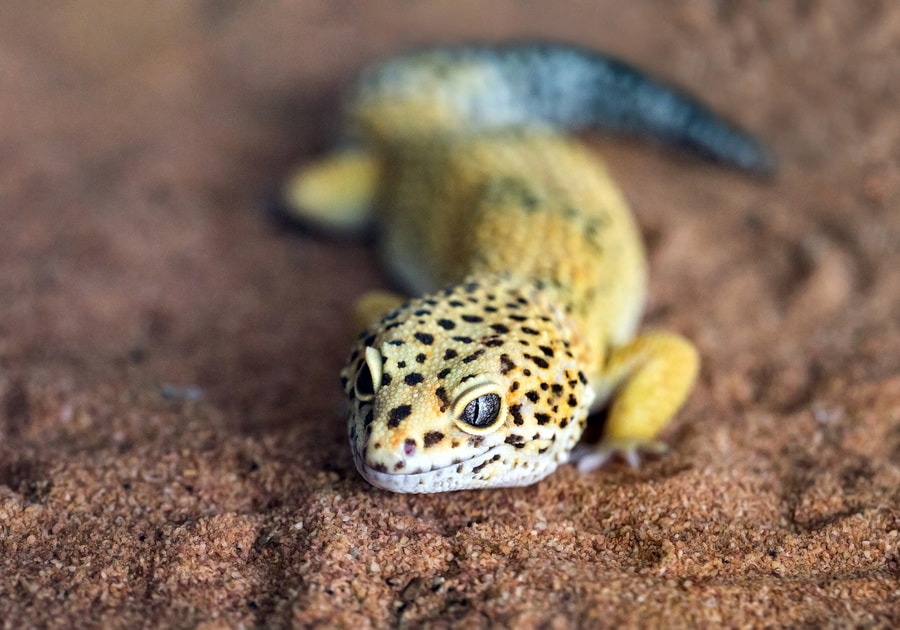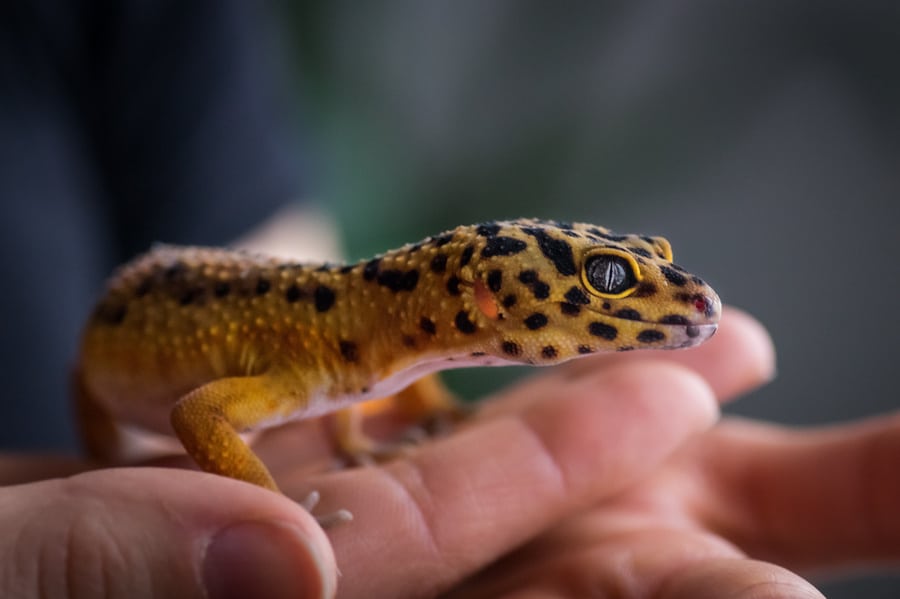
One of the most common questions that people have before they commit to buying a leopard gecko is if leopard geckos smell. So, do leopard geckos smell bad? Let’s find out the truth.
Leopard geckos are not naturally smelly, however, they are naturally curious and will roam around their tank and may walk through their own feces and urine as they do so. Decaying food and dirty enclosures are the most common causes of odor.
The smell can be easily avoided if you commit to cleaning your tank often. To find out everything you need to know about keeping your leopard gecko stink-free and the common causes of a stinky leopard gecko, continue reading.
Common Causes of Leopard Gecko Stink?
Why does your leopard gecko smell? Well, there are a couple of different reasons why this could be. Mostly, a smelly leopard gecko is because of a stinky enclosure, but your leopard gecko could also smell because:
- There are poo and urine in the enclosure.
- Dead insects and leftover food are left in the tank.
- A cricket crawled under decoration and died (this is a common bad smell).
- Your substrate hasn’t been replaced in a while.
- You have not cleaned the enclosure or the decorations.
- Your leopard gecko stepped in its poo and needs a warm bath.
These reasons are the most likely culprit of a smelly leopard gecko tank. Luckily, all the smells can easily be neutralized if you clean your tank.
Is Leopard Gecko Poop Smelly?
Leopard gecko poop is smelly; however, it shouldn’t stink up an entire room. Your leopard gecko’s poop will start to smell if it’s left in the enclosure for days. Additionally, some leopard gecko owners have reported that they do smell the poo if they open the enclosure, but the scent goes away after a few minutes.
If you clean your leopard gecko’s enclosure daily, you are less likely to encounter smelly poo. Generally, leopard geckos use the same spot as their bathroom, so they do make it easy on their owners. However, make sure to check underneath the vivarium décor if your tank still smells after you’ve cleaned up.
How to Make Your Leopard Gecko Smell Better
To make your leopard gecko smell better, you can clean your tank often, bathe your leopard gecko, and replace the substrate in the enclosure.
Clean Your Tank
You should clean the enclosure on a daily, weekly, and monthly schedule. For more detailed information on how to do this, continue reading the sections below.
Replace the Substrate
Depending on the substrate you use, you will need to replace or clean it on a different schedule. The table below shows exactly when you should replace and clean your substrate.
| Substrate | How Often to Replace It or Clean It |
| Newspaper and Paper Towels | Replace 1 to 2 times per week. |
| Reptile Carpet | Daily spot cleaning and replace 2 to 3 times each month. |
| Ceramic Tiles | Daily spot clean and deep clean once a month. |
| All Loose Substrate | Daily spot clean and replace every 3 to 4 months. |
The best way to make sure you replace your substrate often enough is to keep it on a strict schedule. That way, you will not run into the problem of having a stinky vivarium. Additionally, if you change out your substrate you’ll have an easier time managing the smell.
Bath Time
Even though leopard geckos aren’t smelly, they may pick up the stinks in their tank. So, you can give them a bath to help clean them off. Read more on this in the next section.
Bathing a Leopard Gecko
Leopard geckos themselves are not smelly creatures, but if their enclosure is smelly and not cleaned well, the smell may start to smell like a vivarium. So the best way to get the smell of poo off your leopard gecko is to first clean the tank and then bathe your gecko.
While leopard geckos do not need regular bathing because they originate from arid regions that seldom have water, there are some cases that bathing can help your leopard gecko. For example, bathing can help with:
- Cleaning your gecko. Bathing your gecko when you clean your tank can help remove odors.
- Removing dead skin. After shedding, your gecko may have dead skin left over. In the bath, you can gently rub the skin off. But don’t pull or peel the skin off, because that can damage its skin.
- Impaction. If your leopard gecko eats something that it has trouble digesting, it can block your gecko’s digestive system. Sometimes, a warm bath can help dislodge the impacted object. However, if your leopard gecko’s belly is still bloated, contact your vet.
Unclog femoral pores. Male leopard geckos secrete a waxy substance from their pores during the breeding season. Sometimes these pores can become clogged and infected, and a bath will likely dislodge any clogged pores.
You really only need to bathe your leopard gecko one or two times each month. You don’t need to bathe your leopard gecko often because they simply don’t need it. For the best results, plan your gecko’s bath time with cleaning your tank.
How to Bathe Your Leopard Gecko
Bathing your leopard gecko can be a soothing experience for it, so follow these directions for a happy and clean leopard gecko.
Use Shallow Water
When you bath your leopard gecko, only use an inch or two of water. Leopard geckos cannot swim, so you should not submerge them in water. They are simply not built for water and do not like being submerged. You can use a small Tupperware or bowl as your bathtub for the best results.
Watch the Temperature
The temperature of your bath water should be between 90- and 95-degrees Fahrenheit. Because leopard geckos are cold-blooded, their body temperature changes with their environment. So, the temperature of the water will affect your gecko’s body temperature.
We recommend using a thermometer because if your temperature is too cold, your leopard gecko’s body temperature will drop. If the temperature is too hot, you risk burning your leopard gecko. You should always monitor the temperature of the bath and swap out cold water for new water if you notice your bath temperature getting too cold.
Don’t Bathe Too Long
Bath time should only last for 10 to 15 minutes at the most. You should be able to clean and massage your leopard gecko in that time frame and it does not need to bathe for any longer than that.
Always Stay with Your Gecko
Never leave your leopard gecko alone in the bath. Not only is it dangerous, but your leopard gecko could climb out and escape. You should always hold and support your leopard gecko when you bath it.
Pat Your Gecko Dry
When you’re done with bath time, always pat your leopard gecko dry with a paper towel or microfiber towel. Leopard geckos shouldn’t be too wet for long, otherwise, it may become cold and uncomfortable.

Can Diet Affect Leopard Gecko Scent?
Typically, leopard geckos eat beetles, spiders, crickets, mealworms, and other small insects. You should not feed your leopard gecko food meant for other lizards, dog food, cat food, or anything else that has not been approved for leopard geckos because it may cause impaction and other stomach problems. The type of food you feed your leopard gecko should not affect its smell, but some types of food, such as mealworms and crickets, are just smelly. Many gecko owners have reported that the mealworms are smelly, not the leopard gecko.
Safe Ways to Clean Leopard Gecko Enclosure/Cage
When cleaning your leopard gecko’s enclosure, it’s important to keep your leopard gecko safe from cleaning agents, but it’s equally important to keep your health safe as well. Some people opt to use rubber gloves for cleaning, but this is completely up to you. Below we’ll go over the best cleaning agents and how you should sanitize yourself after you’re done cleaning.
Whenever you clean the tank and decorations, always rinse well with water. You don’t want any soap, bleach, vinegar, or cleaning agent left over. Also, let your tank dry for at least 30 minutes before putting it back together. If there’s water left on the tank or décor, it can raise the humidity in the tank.
Dish Soap
Many reptile owners find that simple dish soap can make a great cleaning agent. Just make sure to wash the tank out with water so that there’s no soap residue left over.
Reptile-Approved Disinfecting Agents
You can use cleaning agents made specifically for reptile enclosures, such as Zoo Med or Nature’s Miracle. As with all cleaning agents, make sure to rinse the enclosure out with water before putting everything back in.
Bleach Solution
You can make your own bleach solution that can be used to disinfect the enclosure and all decorations. Your bleach solution should be about 10% bleach (1 part) and 90% water (9 parts).
Vinegar Solution
You can make a weak vinegar solution to wash your tank out with. Generally, you can make a solution that has 1-part white vinegar and 9-parts water (i.e., 1 cup vinegar and 9 cups water; 1 tablespoon vinegar and 9 tablespoon water, etc.).
Wash Your Hands When Finished
You should always wash your hands once you’re done cleaning your leopard gecko’s tank. Not only is cleaning the tank smelly work, but you may be exposed to some bacteria (although, it’s unlikely that you’ll come in contact with anything that will make you sick). So, simply wash your hands in soap and water when you’re done cleaning and try your best to keep your fingers out of your mouth until after you’ve washed them.
6 Tips for Reducing Odor Coming from Leopard Gecko Cage & Room
Luckily, there are ways to reduce the odors that come from your leopard gecko enclosures. For the best tips on how to get rid of leopard gecko smell, read on.
Air Holes in the Ceiling
Instead of having a completely closed-off habitat, choose an enclosure that has holes in the top. That way, you’ll have more airflow and a better chance of smells not hanging around the tank.
Cleaning and Disinfecting
You should clean and disinfect your leopard gecko’s enclosure often. This involves a mix of daily care, weekly care, and a monthly deep clean. The best way to clean your tank is to set up a cleaning schedule, such as:
- Pick up feces and uneaten food each day.
- Look for dead insects and remove them each day.
- Replace water and food every day.
- Replace or clean substrate on a regular schedule.
- Deep clean monthly (see more below).
Daily Cleaning
Daily cleaning should be done to manage the upkeep of your enclosure as well as ensure a healthy environment for your leopard gecko. Each day, you should pick up any feces, replace food and water, and pick up any leftover food. This is also a good time to socialize your leopard gecko, make sure the temperatures are right and make sure your leopard gecko is acting normally.
Deep Cleaning
Every month, you should remove your leopard gecko from its enclosure and deep clean EVERYTHING with your cleaning solution of choice. This involves cleaning everything in the tank, including the walls, decorations, substrate, floor, corners, and even your leopard gecko.
Use Scent Neutralizer
There are some specially made odor neutralizers for reptile enclosures, and you can use products, such as No Scent in the tank if you choose. Just don’t spray it directly on your leopard gecko.
Replace Substrate
There is more information on this above, but if you use paper towels or newspaper, you’ll need to replace these once every week or so to reduce odors. If you use slate rock or stone tiles, you should wash the substrate at least once a month if not every other week. If you use carpet in your enclosure, you should spot clean every day by picking up poo and uneaten food.
